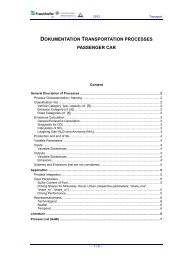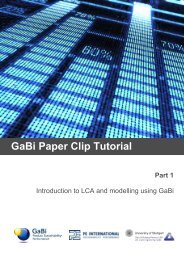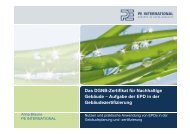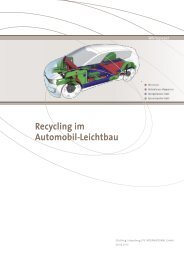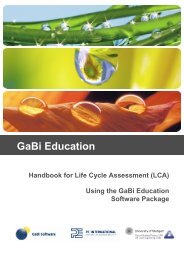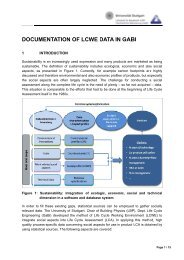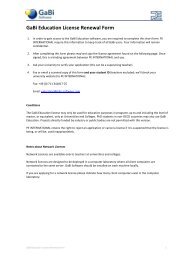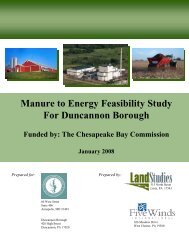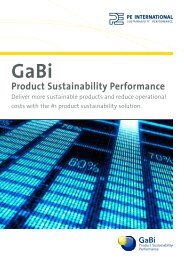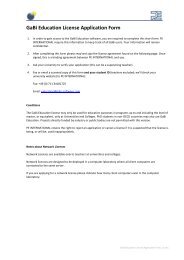here - GaBi Software
here - GaBi Software
here - GaBi Software
You also want an ePaper? Increase the reach of your titles
YUMPU automatically turns print PDFs into web optimized ePapers that Google loves.
3 Information flow within assessment procedure 1<br />
In terms of applied PVC mass, the packaging sector<br />
plays a role, w<strong>here</strong>as the market share in relation to its<br />
competitors is medium to small.<br />
In the transport sector (including cars, trucks, yachts<br />
and trains), PVC is mostly used in small amounts for<br />
numerous applications like plastisol sealing or underbody<br />
protection, body parts, tarpaulins, dashboards,<br />
artificial leather, cable harnesses, foams, fenders and<br />
seat coverings. In some applications within the transport<br />
sector, PVC is the major material in comparison to<br />
competitors, and plastisols and artificial leather play a<br />
larger role in terms of applied mass share.<br />
Within medical applications, PVC plays a major role,<br />
but the mass streams are small.<br />
Agricultural applications are negligible in this context.<br />
Some traps<br />
While gathering information for public decision support,<br />
some traps may be met. Some stakeholders will<br />
always claim that a certain method may not cover a<br />
certain aspect.<br />
Further, it is obvious that decisions have to be based<br />
on solid information. Nevertheless to obtain solid<br />
information, diffuse information has to be neglected at<br />
first in order to get an initial overview. So the goal and<br />
scope of the decision support has to be defined very<br />
carefully, otherwise the analysis gets caught up in<br />
irrelevant information. If important aspects show up<br />
during the analysis, a deeper assessment with other<br />
methods on specific tasks can be carried out once an<br />
overview has been established. It is obvious that the<br />
complete life-cycle has to be considered. But it is also<br />
Baitz et al. Life cycle assessment of PVC in product optimisation and green procurement<br />
common sense that not all parts of the complete lifecycle<br />
must be analysed with the same degree of detail:<br />
concentrate on relevant processes but neglect or simplify<br />
only processes that you know about in detail (‘unfortunately’,<br />
some experience is needed <strong>here</strong>).<br />
Conclusions<br />
Study-related conclusions<br />
The following general conclusions can be drawn on PVC<br />
and its life cycle:<br />
(i) LCA comparisons should be undertaken at the<br />
application level rather than at the material<br />
level. Depending on the type of product, the<br />
environmental impact during use or after endof-life<br />
can be even more important than the<br />
environmental impact of material production<br />
(e.g. fuel saving lightweight parts in automotive<br />
applications or use phase effects of the cleaning<br />
of flooring materials). Approximately 100<br />
LCAs related to PVC have been identified, with<br />
only 30 making comparisons at the application<br />
level.<br />
(ii) LCAs are strongly goal- and scope-dependent.<br />
T<strong>here</strong>fore, two studies on the same product<br />
system may give different conclusions. LCAs do<br />
not aim to evaluate the effects of exposure and<br />
hazard-related data in the way risk assessments<br />
do. LCAs identify the important environmental<br />
aspects and stages over the life cycle and risk<br />
assessments analyse exposure and hazardrelated<br />
information. Both can be used within a<br />
toolbox.<br />
(iii) Within the PVC life cycle chain, the production<br />
of intermediates, particularly the processes from<br />
the extraction of crude oil and rock salt up to<br />
VCM production, plays a major role in environmental<br />
impact.<br />
(iv) From a PVC life cycle perspective, the production<br />
of stabilisers and plasticisers plays a<br />
significant role, w<strong>here</strong>as the production of<br />
pigments offers a comparatively low optimisation<br />
potential, because of the small volumes<br />
used.<br />
(v) Some new technologies exist, e.g. mechanical<br />
recycling based on selective dissolution for<br />
recycling PVC in an economically feasible<br />
way. However, currently only a small amount<br />
of PVC post-consumer waste is being recycled.<br />
Incineration, in conjunction with municipal<br />
waste disposal, is a simple option that allows<br />
for the partial recovery of energy and substances,<br />
if state-of-the-art technology is applied.<br />
(vi) Regarding the positive effects of increasing<br />
recycling rates, mechanical recycling (or material<br />
recycling), which loops the material back<br />
directly into new life cycles, substitutes, to a<br />
certain extent, the processes of resource extraction,<br />
intermediate production and granulation/<br />
polymerisation during the production of virgin<br />
material. Chemical recycling (feedstock recycling)<br />
is another option for recycling PVC into<br />
another life cycle.<br />
(vii) In contrast to some metals, the recycling market<br />
for plastics, and t<strong>here</strong>fore the demand in<br />
Plastics, Rubbers and Composites 2005 VOL 34 NO 3 97



